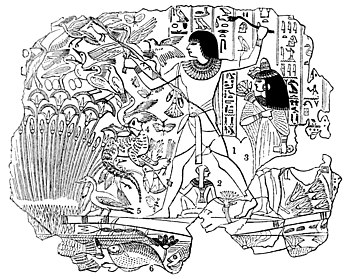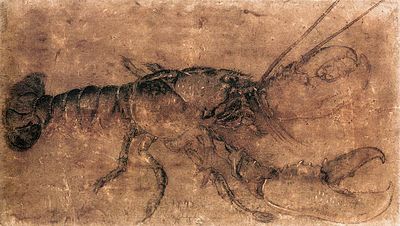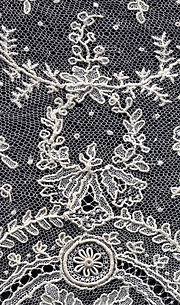Art has many roles and functions in society, ranging from simple description of our lives, to scientific portraits of flora and fauna, to enhancing our everyday lives.
Description
A traditional role of visual art is to describe ourselves and our surroundings. Some of the earliest artworks discovered are drawings and paintings of humans and wild animals on walls deep within prehistoric caves. One recurring image is a hand print: a universal symbol of human communication.

Aboriginal hand stencils, Red Hands Cave, Blue Mountains, New South Wales, Australia
Browse some of the images at the Bradshaw Foundation; see rock art archives in the left navigation menu of that website. The Bradshaw Foundation’s primary objective is to discover, document, and preserve ancient rock art around the world and to promote the study of early humankind’s artistic achievements.
Portraits capture the accuracy of physical characteristics, but the very best also transfer a sense of an individual’s unique personality. For thousands of years, this role was reserved for images of those in positions of power, influence, and authority. The portrait not only signifies who they are, but also solidifies class structure by presenting only the highest-ranking members of a society. The portrait bust of Egyptian Queen Nefertiti exemplifies beauty and royalty. The full-length Imperial Portrait of Chinese Emperor Xianfeng not only shows realism in the likeness of the emperor, but also exults in the patterns and colors of his robe and the throne behind him.
-
Bust of Nefertiti, painted sandstone, Egypt, c. 1370 BCE. Neues Museum, Berlin
-
Imperial Portrait of Emperor Xianfeng, China, c. 1855. Palace Museum, Bejing

Nebamun Hunting Fowl, fresco, Egypt, c. 1350 BCE. British Museum, London
Landscapes, by themselves, give us detailed information about our natural and human made surroundings; things like location, architecture, time of day, year, or season, plus other physical information such as geological elements and the plants and animals within a particular region. Nebamun Hunting Fowl is loaded with specific plant and animal life in Egypt’s Nile river delta. This wall painting shows the scribe Nebamun as he stands in a reed boat near a thicket of papyrus capturing ducks. His cat actively grabs at two birds as they try to fly away. Amongst the different species are hawks, butterflies, herons, songbirds, and fish. The figure sitting in the boat is his daughter. The larger female figure standing at the stern is his wife. The artist records the scene in great detail; he paints every feather on the birds and every scale on the fish beneath the boat.

Albrecht Durer, Lobster, 1495. Staatliche Museen, Berlin
Indeed, in many western cultures, the more realistic the rendering of a scene the closer to our idea of the truth it becomes. In the fifteenth century, German artist Albrecht Durer created vivid works that show a keen sense of observation. His Lobster is uncanny in its realism and sense of animation.

Banksiea coccinea (Illustrationes Florae Novae Hollandiae plate 3)
Out of this striving for accuracy and documentation developed the art of scientific illustration, an important part of scientific communication before the advent of photography. Scientific illustrators concentrate on accuracy and utility rather than aesthetics. They comment on many different types of scientific phenomena.

Detail of needle lace
Enhancing the world of our everyday lives is another role art plays. This role is more utilitarian than others. It includes textiles and product design; embellishments to the items we use everyday; and all the aesthetic considerations that create a more comfortable and expressive environment.
Read about how the Wari peoples of Peru used art to enhance their everyday implements.
Comment on the purpose and use of portraits of public officials in public buildings.
You must be logged in to post to WEnotes.
Note: Your comment will be displayed in the course feed.
Roles of art in society
Art has many roles and functions in society, ranging from simple description of our lives, to scientific portraits of flora and fauna, to enhancing our everyday lives.
Description
A traditional role of visual art is to describe ourselves and our surroundings. Some of the earliest artworks discovered are drawings and paintings of humans and wild animals on walls deep within prehistoric caves. One recurring image is a hand print: a universal symbol of human communication.
Early Art
Browse some of the images at the Bradshaw Foundation; see rock art archives in the left navigation menu of that website. The Bradshaw Foundation’s primary objective is to discover, document, and preserve ancient rock art around the world and to promote the study of early humankind’s artistic achievements.
Portraits
Portraits capture the accuracy of physical characteristics, but the very best also transfer a sense of an individual’s unique personality. For thousands of years, this role was reserved for images of those in positions of power, influence, and authority. The portrait not only signifies who they are, but also solidifies class structure by presenting only the highest-ranking members of a society. The portrait bust of Egyptian Queen Nefertiti exemplifies beauty and royalty. The full-length Imperial Portrait of Chinese Emperor Xianfeng not only shows realism in the likeness of the emperor, but also exults in the patterns and colors of his robe and the throne behind him.
Bust of Nefertiti, painted sandstone, Egypt, c. 1370 BCE. Neues Museum, Berlin
Imperial Portrait of Emperor Xianfeng, China, c. 1855. Palace Museum, Bejing
Landscapes
Landscapes, by themselves, give us detailed information about our natural and human made surroundings; things like location, architecture, time of day, year, or season, plus other physical information such as geological elements and the plants and animals within a particular region. Nebamun Hunting Fowl is loaded with specific plant and animal life in Egypt’s Nile river delta. This wall painting shows the scribe Nebamun as he stands in a reed boat near a thicket of papyrus capturing ducks. His cat actively grabs at two birds as they try to fly away. Amongst the different species are hawks, butterflies, herons, songbirds, and fish. The figure sitting in the boat is his daughter. The larger female figure standing at the stern is his wife. The artist records the scene in great detail; he paints every feather on the birds and every scale on the fish beneath the boat.
Scientific illustrations
Indeed, in many western cultures, the more realistic the rendering of a scene the closer to our idea of the truth it becomes. In the fifteenth century, German artist Albrecht Durer created vivid works that show a keen sense of observation. His Lobster is uncanny in its realism and sense of animation.
Out of this striving for accuracy and documentation developed the art of scientific illustration, an important part of scientific communication before the advent of photography. Scientific illustrators concentrate on accuracy and utility rather than aesthetics. They comment on many different types of scientific phenomena.
Enhancing our world
Enhancing the world of our everyday lives is another role art plays. This role is more utilitarian than others. It includes textiles and product design; embellishments to the items we use everyday; and all the aesthetic considerations that create a more comfortable and expressive environment.
Art in Everyday Life
Read about how the Wari peoples of Peru used art to enhance their everyday implements.
Comment on the purpose and use of portraits of public officials in public buildings.
You must be logged in to post to WEnotes.
Note: Your comment will be displayed in the course feed.
Content is available under the
Creative Commons Attribution Share Alike License.
Privacy Policy | Authors